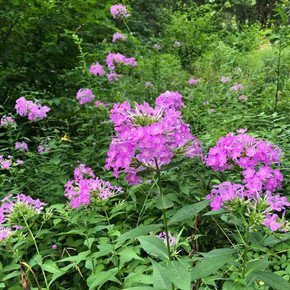
Phlox paniculata 'Robert Poore' - GARDEN PHLOX 'ROBERT POORE'
This phlox is named after the landscape architect Robert Poore, who discovered it at an abandoned homestead in Mississippi decades ago. He shared it with Barbara Boys (Southern Perennials and Herbs) who recognized its superior performance and introduced it to the nursery trade. This cultivar is highly rated by the Chicago Botanical Gardens and in the trials at North Carolina State University and University of Arkansas for good powder mildew resistance and low-to-no infection by spider mites. In the Mt. Cuba Center phlox trials, it developed some mildew in the second and third year of testing, but it's still highly recommended for the Midwest gardening region.
Sturdy, robust, 5' upright perennial with bigger, intensely fragrant magenta flowers in big 7" wide clusters. The best uses are in flower beds, private and public landscaping projects, cottage gardens, hummingbird and butterfly gardens, or woodland edge; it can also be used for some naturalization.
Beautiful combinations can be made with other perennials such as Agastache, Coreopsis (C. tripteris and cultivars, C. verticillata, C. palustris 'Summer Sunshine'), Echinacea (E. purpurea and it's nativars, E. tennesseensis, Eupatorium, Filipendula rubra ‘Venusta‘ or its wild form, Helenium, Monarda didyma, other varieties of Phlox paniculata, Rudbeckia ( R. maxima, fulgida, laciniata), Veronicastrum or cultivars of grass Panicum virgatum.
Good non-native perennial combinations include taller Astilbe, Dephinium, taller Geranium, Hemerocallis, Leucanthemum superbum, Lilium, Persicaria amplexicaulis, Sanquisorba, Scabiosa caucasica or Thalictrum.
Pictures copyright : Mt. Cuba Center
Blooming Time: mid summer; blooms for six weeks (deadheading prolongs the blooming season and prevents unwanted seedlings)
Size: 4-5’ tall x 2’-3 wide, spacing 2-3’
USDA Zones: 4 to 8
Culture: full sun, half sun, light shade. Grows well in average garden soil, loam, clay, and average garden soils - mulching is beneficial.
Moisture Needs: medium, medium moist
Origin: Garden origin. The distribution of the wild species of Phlox paniculata may be found on the USDA's website.
Deer/Rabbit Resistant: no / no (needs some protection)
Attracts Butterflies or Pollinators: butterflies, native bees, honey bees
Attracts Hummingbirds: yes
Pot Size: square 3.5" x 5" deep pot

Phlox paniculata 'Robert Poore' - GARDEN PHLOX 'ROBERT POORE'
This phlox is named after the landscape architect Robert Poore, who discovered it at an abandoned homestead in Mississippi decades ago. He shared it with Barbara Boys (Southern Perennials and Herbs) who recognized its superior performance and introduced it to the nursery trade. This cultivar is highly rated by the Chicago Botanical Gardens and in the trials at North Carolina State University and University of Arkansas for good powder mildew resistance and low-to-no infection by spider mites. In the Mt. Cuba Center phlox trials, it developed some mildew in the second and third year of testing, but it's still highly recommended for the Midwest gardening region.
Sturdy, robust, 5' upright perennial with bigger, intensely fragrant magenta flowers in big 7" wide clusters. The best uses are in flower beds, private and public landscaping projects, cottage gardens, hummingbird and butterfly gardens, or woodland edge; it can also be used for some naturalization.
Beautiful combinations can be made with other perennials such as Agastache, Coreopsis (C. tripteris and cultivars, C. verticillata, C. palustris 'Summer Sunshine'), Echinacea (E. purpurea and it's nativars, E. tennesseensis, Eupatorium, Filipendula rubra ‘Venusta‘ or its wild form, Helenium, Monarda didyma, other varieties of Phlox paniculata, Rudbeckia ( R. maxima, fulgida, laciniata), Veronicastrum or cultivars of grass Panicum virgatum.
Good non-native perennial combinations include taller Astilbe, Dephinium, taller Geranium, Hemerocallis, Leucanthemum superbum, Lilium, Persicaria amplexicaulis, Sanquisorba, Scabiosa caucasica or Thalictrum.
Pictures copyright : Mt. Cuba Center
Blooming Time: mid summer; blooms for six weeks (deadheading prolongs the blooming season and prevents unwanted seedlings)
Size: 4-5’ tall x 2’-3 wide, spacing 2-3’
USDA Zones: 4 to 8
Culture: full sun, half sun, light shade. Grows well in average garden soil, loam, clay, and average garden soils - mulching is beneficial.
Moisture Needs: medium, medium moist
Origin: Garden origin. The distribution of the wild species of Phlox paniculata may be found on the USDA's website.
Deer/Rabbit Resistant: no / no (needs some protection)
Attracts Butterflies or Pollinators: butterflies, native bees, honey bees
Attracts Hummingbirds: yes
Pot Size: square 3.5" x 5" deep pot











